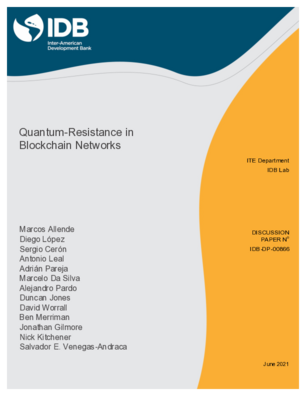Quantum-Resistance in Blockchain Networks
Date issued
Jun 2021
Subject
Blockchain;
Ethereum;
Cloud Computing;
Science and Technology;
Cybersecurity;
Loan Operation;
Internet;
Digital Identity;
LACChain;
Cryptocurrency;
Smart Contract;
Digital Signature;
Cyberthreat;
Cryptographic Control
JEL code
O32 - Management of Technological Innovation and R&D;
C60 - Mathematical Methods • Programming Models • Mathematical and Simulation Modeling: General
Category
Discussion Papers
This paper describes the work carried out by the Inter-American Development Bank, the IDB Lab, LACChain, Cambridge Quantum Computing (CQC), and Tecnológico de Monterrey to identify and eliminate quantum threats in blockchain networks. The advent of quantum computing threatens internet protocols and blockchain networks because they utilize non-quantum resistant cryptographic algorithms. When quantum computers become robust enough to run Shor's algorithm on a large scale, the most used asymmetric algorithms, utilized for digital signatures and message encryption, such as RSA, (EC)DSA, and (EC)DH, will be no longer secure. Quantum computers will be able to break them within a short period of time. Similarly, Grover's algorithm concedes a quadratic advantage for mining blocks in certain consensus protocols such as proof of work. Today, there are hundreds of billions of dollars denominated in cryptocurrencies that rely on blockchain ledgers as well as the thousands of blockchain-based applications storing value in blockchain networks. Cryptocurrencies and blockchain-based applications require solutions that guarantee quantum resistance in order to preserve the integrity of data and assets in their public and immutable ledgers. We have designed and developed a layer-two solution to secure the exchange of information between blockchain nodes over the internet and introduced a second signature in transactions using post-quantum keys. Our versatile solution can be applied to any blockchain network. In our implementation, quantum entropy was provided via the IronBridge Platform from CQC and we used LACChain Besu as the blockchain network.



